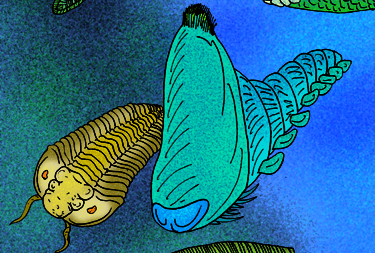- Ainiktozoon
Taxobox | name = "Ainiktozoon loganense"
fossil_range =Silurian

image_caption = "Calymene blumenbachi" & "Ainiktozoon loganese"
regnum =Animal ia
phylum =Arthropod a
subphylum = Crustacea
classis =Thylacocephala
ordo = Concavicarida
genus = "Ainiktozoon"
species = ""'A. loganense"
binomial = "Ainiktozoon loganense"
binomial_authority = Scourfield, 1937"Ainiktozoon" is an enigmatic
fossil genus from theSilurian ofScotland . Originally described as an earlychordate , recent studies suggest that was in fact anarthropod , more precisely acrustacean belonging to the little known extinct classThylacocephala .The only discovered species "Ainiktozoon loganense" is known from a number of specimens from Silurian rocks (
Llandovery series) atLesmahagow in Scotland. "Ainiktozoon" is Greek for "puzzling animal".It probably fed by swimming close against flat sea bed and sucking up
detritus . Fact|date=April 2008If a
predator came near, it may have escaped upwards by violently expelling all the water downwards from its pharynx. Some fossils seem to show what may be a hardened area on the top (bottom on [http://www.btinternet.com/~vendian/FOSSILWEB/images/drawanik.jpgthe drawing] ) of its hump: this may have been to protect the top of its hump if it hit a rock overhang during this escape action. Fact|date=April 2008External links
* [http://www.btinternet.com/~vendian/FOSSILWEB/images/ Images of Ainiktozoon] (see the files whose names start "ain".)
References
*cite journal |quotes=no |author=Ritchie, A. |year=1985 |title="Ainiktozoon loganense" Scourfield, a protochordate? from the Silurian of Scotland |journal=Alcheringa |volume=9 |pages=117–142
*cite journal |quotes=no |author=Van der Brugghen, W., F. R. Schram & D. M. Martill |year=1997 |title=The fossil "Ainiktozoon" is an arthropod |journal=Nature |volume=385 |pages=589–590 |url=http://www.nature.com/nature/journal/v385/n6617/abs/385589a0.html |doi=10.1038/385589a0
Wikimedia Foundation. 2010.
